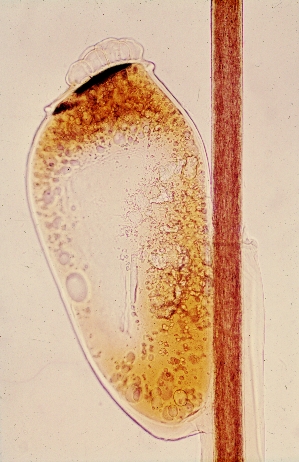Arthropods are the most diversified animals on Earth, many of them parasites. A 125-million-year-old fossil flea has been unearthed in China that stung pterosaurs. Parasitic groups are mainly mites (which are arachnids) and insects.
Many of the parasitic arthropods are unpleasant companions of the humans, cattle and companion animals. Fleas, ticks and horseflies transmit diseases to livestock and companion animals, and some of them are zoonoses, which affect the humans. In addition to the health problem, we must add the economic problem, because the economic losses caused by illness and stress are enormous.
In humans, there are many and varied parasitic arthropods that attack them, such as lice, crabs, bedbugs, fleas, mange, etc. If in the past they were quite common, today they are much less by the advances in the hygiene and the sanity. But nevertheless, they follow us closely, and from time to time there appears an outbreak of lice in children or some unexpected nocturnal attack of bed bugs to remind us that our parasites are there, lurking.
Parasites are so important that they have changed the history of mankind. Black Death was reportedly first introduced to Europe via Genoese traders at the port city of Kaffa in the Crimea in 1347. The Oriental rat flea (Xenopsylla cheopis) is the primary vector for the transmission of Yersinia pestis, the organism responsible for bubonic plague. It killed some 75 to 200 million people in Eurasia and more like 45–50% of the European population dying during a four-year period, areas such as Italy, the south of France and Spain it was probably closer to 75–80% of the population. The Black Death created a series of religious, social, and economic upheavals, whith profound effects on the course of European history.
The identification of the parasite is fundamental for the correct diagnosis of the parasitosis. The size of the parasitic arthropods is usually macroscopic, so that identification can often be done with the naked eye or with the stereomicroscope, but in some cases it is advisable to use the microscope for microscopic or very small parasites (such as the itch mite) ) or appreciate certain structures of the same.
Background
- Reading: Para-Site. Arthropod Parasites
Procedure
This experiment consists of identifying some of the common parasitic arthropods, checking their differences and highlighting their identification characters. To this end, a series of parasitic arthropods will be observed visually and under the microscope.
For the identification of arthropods:
- Reading: Blaine A. Mathison and Bobbi S. Prittb. Laboratory Identification of Arthropod Ectoparasites
Ways to perform the experiment
1. In Laboratory
The laboratory that performs parasitic arthropodology experiments and tests, must have a supply of samples, adequate instruments and staff training. If this is not possible, the microscopic preparations can be purchased. The microscopic preparations of arthropod parasites usually cost about 8-10 dollars each. If macroscopic samples of arthropods are not available, a good and alternative option is to make visits to museums of Natural History.
2. In Home Lab
In principle, the experiment is not dangerous if carried out with commercial microscopic preparations. For the experiment it is necessary to have a stereomicroscope something better than a toy. There are possibilities for setting up a low cost home microscopy lab (in spanish).
If macroscopic samples of arthropods are not available, a good alternative option is to make visits to museums of Natural History.
3. Virtually
For this purpose, microscopic images of parasitic helminths can be made in the same post in the next section.
Images of helminth parasites
Click on the image to enlarge.
 |
| Sarcoptes scabiei |
.jpg/800px-Ixodes_hexagonus_(aka).jpg) |
| Ixodes hexagonus |
 |
| Ixodes ricinus (castor bean tick) |
 |
| Louse egg in head hair |
 |
| Pediculus humanus |
 |
| Pthirus pubis |
 |
| Cat flea (Ctenocephalides felis) |
| Cimex lectularius |
Crab louse (Pthirus pubis)
Human head louse (Pediculus humanus)
Human flea (Pulex irritans)
1.- Draw the observed arthropods.
2.- Make a table or diagram of identification of the observed arthropods.
3.- Indicate the identifying characters of each arthropod observed, a small description and their parasitological importance.
4.- Search the Internet for images of arthropod parasites.
5.- Enter into the website Texas Agricultura & Life Sciences Agrilife Extension and search arthropod parasites.
Spanish version of this page
Parasitology







0 comentarios:
Publicar un comentario